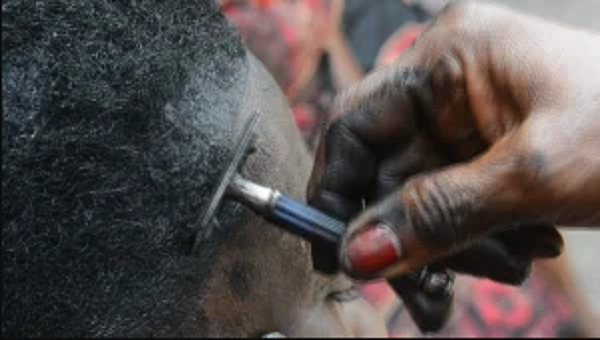Here’s the Ghanaian haircut that has reigned for over 200 years

You must have seen Akan queens rocking a uniformed low haircut, with a thick black dye forming the shape of a calabash on their foreheads, and wondered what is represented.
Typically styled by queens belonging to the Akan tribe, particularly the Asantes, this particular hairstyle is known as the Dansinkran. It is an indigenous haircut that has existed for over twenty (20) decades.
The hairstyle, worn by ‘female kings’, queen mothers, and some priestesses within the Akan jurisdiction is said to symbolize authority and royalty.
What is its origin?
Although there are several twists to the inception of this hairstyle, there are two most prevalent stories.
The first story detailed that Nana Kwaadu Yiadom II, the queen mother of the Asante Kingdom and sister of Nana Prempeh I, once performed the regal ‘Adowa’ dance during the Asante Confederacy’s restoration and the ‘Dansinkran’, then ‘Kentenkye’ hairstyle, was first spotted on her.
The reigning Governor at that time was said to have referred to her hairstyle as a “dancing crown” because of its aesthetic appeal during the dance.
Afterward, the term “dancing crown” was verbally altered into ‘Dansinkran’, which has since become its name today.
In the second story however, during the 1824 Katamanso war when the British joined forces with other tribes to defeat the Asantes, the ‘Dansinkran’ hairstyle, then known as ‘Gyese Nkran’, was introduced and worn by the Asante women to mourn the Asantehene who died in the war.
It is, however, unknown why it was labeled ‘Gyese Nkran’.


Its significance
Aside from representing power and wealth, the ‘Dansinkran’ hairstyle distinguishes the queen mothers and women of the royal family from other people.
Although in recent times, other women wear Dansinkran, the queen mother’s style is exceptional because they work on their hair daily, whereas other women wear it only on special occasions.
Some customs associated with the hairstyle
The ‘Dansinkran’ hairstyle is usually adorned to pay homage to dead Akan royals (kings and queens).
In the event of death, royal women not adorned in Dansinkran are not allowed to file past the dead bodies of kings or queens.


The transitioning into a modern day ‘sweat hairstyle’
The Dansinkran hairstyle, usually meant for royals and the elderly, has stood the test of time.
In recent times, the youth has embraced it and created a ‘modern look’ known as ‘Sweat’.
The difference is that the ‘Sweat’ is a unisex style and is also not done with the shiny dark mixture applied to the hair.
Some traditional brides nowadays also rock the Dansinkran hairstyle to meet their husbands and in-laws.

What is the thick black dye in the haircut made of?
The thick black dye spotted at the edges of the haircut is made up of a mixture of charcoal soot from a cooking pot or fire lamp, and shea butter.
It is believed that the dye used on the hair enhances the thinking capabilities of the wearer.


Photo credits: Ansah Ken Photography, Inno Lens, Yaw Opare Photography
Research tools: ciafe.org, GMB-TV3





